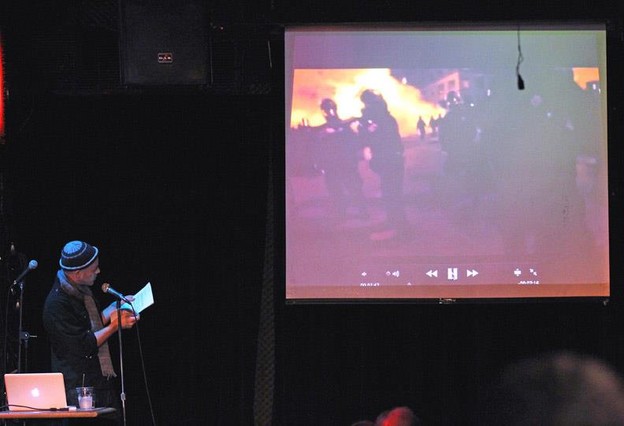Someplace other than what he read and the video he showed
David Buuck and the reenactment of Occupy Oakland

This past Saturday David Buuck presented at the Bowery Poetry Club for the Segue Series. I say “presented,” rather than “read,” as his reading featured video and song in addition to recitation. David has been exploring a very interesting range of problems in an expanded field of poetry for some time. Some of this is contained in his book The Shunt, which appeared with Palm Press in 2009. Yet the majority of it has been documented through pamphlets the poet-artist-theorist has put out himself, under the moniker BARGE, which stands for The Bay Area Research Group in Enviro-aesthetics, and more recently on Vimeo.
While I have long admired David’s performances, which blend constraint-based writing with movement, dance, and music, this Saturday had an added urgency as he addressed conflicts between participants in the occupy movement and police in his native Oakland.
For years David and I have had an ongoing conversation about the uses (and abuses) of “reenactment” for public demonstration and aesthetic intervention. His 2008 work, Buried Treasure Island (which I discuss in a previous article at Jacket 2, on “Somatic Poetics”), features “pre-enactments” of what he hopes will be future ecological actions and sites, figured through the artist Gordon Matta-Clark for whom he has named a yet-to-be-remediated “park” on the island.
Reenactment came up in a different way through the performance at Segue, where David first read what seemed to be a series of instructions for dance and/or movement (like ones a Yoga instructor might give, or he and I might give our students at Bard College’s Language and Thinking workshop). After reading these instructions — to bend your arm so many degrees, to place your chest on the ground, to exhale in a particular way — David proceeded to read from an Oakland police blotter, which he told me afterwards had been leaked by the hacktivist Anonymous only days before.
Like much conceptual reappropriation, David’s reading from the blotter was interesting for the ways that it framed the Oakland police, whose history of corruption and violence are notorious, going back to the Black Panthers and other activist groups of the 60s and 70s. When David finished reading from the blotter, a video projection from his laptop was cued. As soon as the video came on and David started reading, one could hear resonances with the first text he had read. Only now he provided an image track giving this language context for the first time in the performance.
The video was compiled from Livestream and cellphone footage of occupiers clashing with police. Often it was pixellated, a fact that David’s text described repeatedly, the pixellation enacting the withdrawal of the image’s representational power, abstracting an erstwhile documentary content. Most of all, for me, the pixellation embodied an affective content; it obscured events which could not easily be represented, and which instead demanded witness — specifically the body brutalized and made vulnerable, armorless before a phalanx of fully-armored cops. In other footage one saw an equally beautiful (and fairly abstract) image of a camera being dropped to the ground, pointing at the sky as it inadvertently recorded the silhouettes of police beating citizens with truncheons. In yet another video, a woman was flung onto pavement face first by police. David replayed these discrete videos in slow motion, synching them with his minute descriptions of movements and gestures depicted in the footage.
As David also commented to me afterwards during an extensive conversation about his involvement in the Oakland occupation, where his performance may have seemed to attempt to reenact scenes from the occupation, it instead foregrounded the impossibility of successful reenactment, the bodies that produced its context being withdrawn from us, the social conditions that produced that context someplace other than what he read and the video he showed. It reminded me of something Adorno says in Aesthetic Theory, that we reenact what could not be felt the first time around. Through his use of bodily and textual constraint, and through tactical remediation and recontextualization, David touches an affective content that we might otherwise not feel through the representation of political and social traumas, traumas which for many have become deeply personal through their involvement with the occupy movement.
To conclude the performance, David showed footage of a GA assembly in Oakland, the facilitator speaking through the People’s Microphone while using American Sign Language to communicate with the assembly simultaneously. While doing so he sang a song, the words of which were obscure, if they were words at all. As if to foreground the production of language in a body. That the song was sung live while the video played silently also amplified a sense of false return. The unheimlich of almost uttering words, as though a lack of articulation could compensate for us not having been ‘there.’
SELF | LIFE | WRITING